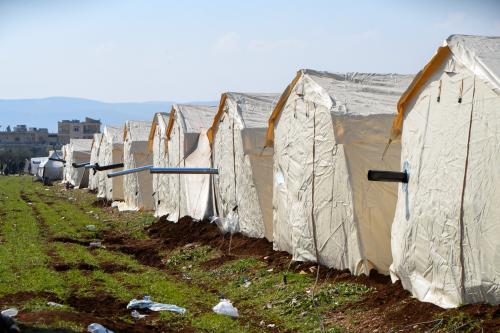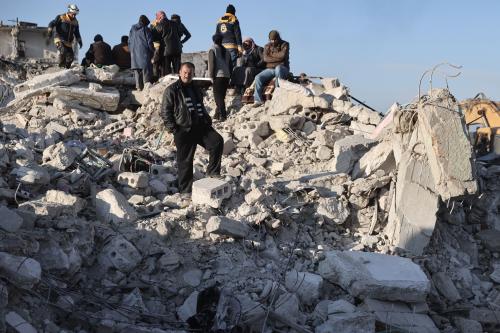The international humanitarian system is presently over-stretched with multiple mega-crises requiring not only billions of dollars, but creative attention from harried policymakers. From Iraq to Syria to Ukraine to South Sudan to Ebola (not to mention Myanmar, Libya, the Central African Republic, Somalia, and dozens of others), the past year has been a disaster for the disaster community.
It is time to re-think the fragile, imperfect international humanitarian system—a task which is incredibly difficult as those needed to do the creative thinking are bogged down in responding to too many crises. It’s like asking a fire department to step back from a four-alarm blaze and ‘reflect on the big picture.’ Nonetheless the World Humanitarian Summit (WHS) is trying to do just that.
Over the course of the past year, regional WHS consultations have been held in five regions with another three scheduled to take place in the coming months. These regional gatherings bring together governments, nongovernmental organizations, international organizations, academics, civil society representatives, and others to discuss the burning humanitarian concerns of the region. Thousands of people participate in these regional meetings and the parallel online consultations. The summaries of those consultations are rather a laundry list of the issues at hand, but in my mind they raise a fundamental question about where regional bodies fit in the international system.
The Sendai Framework for Disaster Risk Reduction 2015-2030 adopted last month, is chock full of references to regional organizations, ascribing them an important role in every aspect of disaster risk reduction. But what should we expect from regional organizations? What can they do that national governments cannot? Are there tasks that they can do better than the international bodies? What would it take for them to become more active in preparing for, responding to, and recovering from crises?
For the past few years, the Brookings-LSE Project on Internal Displacement has carried out research on regional organizations, including analysis of their roles in disaster risk management, case studies of the Pacific and the Caribbean and, most recently, research into the way in which they build capacity at the national level. It is actually quite surprising that there isn’t more academic research on regional bodies other than European organizations. While international relations theorists have written about the growing development of regional bodies, most of this literature focuses on trade, diplomacy, security, and peace. A notable exception is the work of the Overseas Development Institute which has written on the role of regional organizations in humanitarian action, on the Association of Southeast Asian Nations (ASEAN), and the Organization of Islamic Cooperation and which brought together the humanitarian officers of regional organizations earlier this year.
It must be said that presently, most regional organizations are relatively weak. They depend on external funders for most of their humanitarian work. They are overshadowed in the area of humanitarian response by international organizations. Moreover, the landscape of regional organizations is a complex one with many regional bodies with overlapping memberships. This complicated landscape makes it difficult to know exactly who is doing what and creates pressure for small countries to participate in meetings of multiple regional bodies.
Were I to design the international humanitarian system from scratch, I would make regional organizations central actors. Although there are always political sensitivities in intra-regional dynamics, the fact is that regional bodies are closer to affected communities, often share histories, language, and culture with countries in the region, and their work costs less than international organizations with headquarters in Europe and North America. As one Central American disaster responder said to me, “we’d rather have someone from our region come when we need help—someone who speaks our language and knows what we need.”
I see at least three ways that regional organizations can increase their role in the international humanitarian system.
- Setting regional standards on internal displacement. Africa and the Americas made important contributions to the field of international refugee law through the Organization of African Unity Convention on Refugees and the Cartagena Declaration—and more recently by Cartagena +30. The African Union has developed a regional convention on internally displaced persons, the Kampala Convention. Given the fact that the number of internally displaced persons (IDPs) globally has skyrocketed, this is an area where regional initiatives are needed. Why not a declaration, an agreement, a treaty on IDPs in the Americas? Or in the Middle East, which has experienced the largest increase in internal displacement in recent years? This is an area where regional organizations could use their convening power and their sensitivity to realities in the region to come up with regional instruments which would protect the rights of those displaced in a way that is closer to home than frameworks developed at the global level.
- Stimulating development of national laws to facilitate disaster assistance. The International Federation of Red Cross and Red Crescent Societies has done pioneering work in supporting governments to develop laws to make response to disasters easier. This is an area where regional organizations could support national governments to develop laws and policies that will make response easier when disaster strikes.
- Bringing together different regional networks. Just as complaints abound about the siloed nature of international action, so too do parallel regional networks, sometimes created by external funders, work in the same areas. For example, in most regions, there are separate networks working on climate change adaptation and disaster risk reduction although they are involved in similar sorts of actions. Merging institutions is never easy—there are too many vested interests—but the more these multiple regional bodies cooperate with one another, the more effective they will be. Regional civil society organizations—from churches to educational institutions to human rights groups—provide important resources to support these networks.
While we’re not creating a new international humanitarian system from scratch, I believe there is a role for regional organizations to play a much more active role in preparing for, responding to, and recovering from humanitarian crises in their regions. The international agencies certainly don’t have all the answers. It’s time for the regions to step up, for the internationals to give them space, and for national governments to give them the tools—and the money—they need.


Commentary
Where, oh where, do regional organizations fit in the international humanitarian system?
April 17, 2015